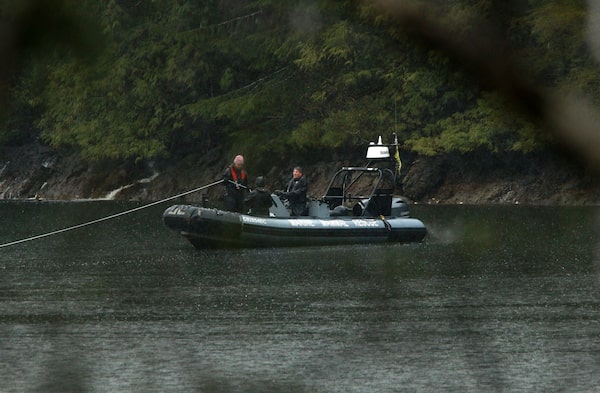
Fisheries Department Pacific region marine mammal co-ordinator Paul Cottrell operates a zodiac with other experts as they conduct work in an area where an orphaned two-year-old female orca calf continues to live in a lagoon near Zeballos, B.C., on April 11.CHAD HIPOLITO/The Canadian Press
Jeff Foster’s resume sounds like the stuff of fantasy, starting as a teenage orca catcher in Puget Sound in Washington State, pursuing the giant predators for aquariums for decades, then having a change of heart and becoming a leading figure in killer whale rescue and rehabilitation.
The 68-year-old American says he got a call from Canada’s Department of Fisheries last month, for advice about how to capture a young orca that has now been trapped in a remote Vancouver Island lagoon for more than three weeks.
He said in an interview that rescuers should try to connect with the female calf, that the Ehattesaht First Nation has named kwiisahi?is, meaning Brave Little Hunter.
“The most important thing is trying to develop a rapport with the animal, but not a strong bond that they become attached to you,” said Foster, who now works with the Whale Sanctuary Project, a group dedicated to rehousing captive cetaceans in an ocean sanctuary.
“That’s kind of tricky. You just have to, you know, analyze the animal’s behaviour they’re like people, each animal is different, and you have to try different things.”
Foster cited his involvement in the 2002 rescue of Springer, a juvenile killer whale that turned up alone in central Puget Sound in 2002, before being successfully captured and released safely in waters off B.C.
Foster said they found a stick that Springer had been playing with, using it as a “security blanket.”
He said the rescuers tied a rope to the stick, threw it out and gradually drew Springer closer and closer to their boat.
“And so, what we were able to do with Springer was to be able to rub her down in a way that she would present her tail, so we can put a soft tail line on her and then catch her with the least amount of stress possible,” said Foster.
The team of rescuers at the lagoon 450 kilometres northwest of Victoria failed in their initial attempt to capture the young orca last Friday. They say the whale dodged efforts to corral it in shallow water, and they are rethinking their tactics.
Foster said he became involved with capturing orcas at 15 for the now-closed Seattle Marine Aquarium. He has experience catching killer whales for captivity, research and rescue purposes in the U.S., Norway, and New Zealand.
He said the Department of Fisheries reached out as soon as the calf’s mother died in the lagoon on March 23.
He said he immediately offered to bring his crew and capture equipment to Vancouver Island, but he hasn’t heard back from the department.
“I would love to get up there and help out and we’ve offered our services and we have a team of people that are very best in the world for this kind of stuff But I get the feeling that DFO and the Vancouver Aquarium want to do this on their own,” he said, adding that this was not a criticism.
“They are doing their best job,” said Foster.
The department did not provide a direct response when asked if it had consulted experienced orca catchers.
It said Monday that a new attempt to rescue the calf would be finalized in the next few days but no date has been set.
Rescuers, who include members of the Ehattesaht First Nation, said on Friday that a change in strategy may be needed, possibly including an attempt to net the whale in a deeper section of the lagoon.
Foster said the calf was likely scared to leave the lagoon. “It’s confused maybe it doesn’t want to leave the beach where the mom stranded,” he said.
Foster said that various techniques were used in the early days of the whale-capturing industry, including open ocean captures in Iceland.
In the Pacific Northwest during the 1970s, some hunters would net off a whole bay off to catch orcas inside.
Foster said he and his crew used to herd orcas by throwing small explosives called “seal bombs” and boats would push them into shallow water, before setting a purse-seine net around them.
He recalled the high-pitch vocalizations made by the orcas when they separated young calves from their mothers, likening it to the sound of babies’ crying.
Foster said he eventually became disenchanted with the industry and the justification that keeping orcas in aquariums was helping educate the public.
He is now working to establish a sanctuary in Port Hilford Bay, Nova Scotia, to house orcas that were once held in aquariums.